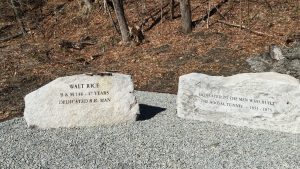The two sides of the tunnel offer completely different atmospheres. On one side, the mark of humans, as if in a post-apocalyptic world. The other, the bruise of human interaction at every turn.
The West Portal is marked by age. Every part of the area is weathered and worn. A muddy, dirt path, covered by snow on all sides, leads from the road. It is barely wide enough for a car, with tracks in the mud too wide and deep for a low car to pass safely through.
A yellow gate that is never closed marks the entrance. Like other parts of the tunnel, it is rusty, covered in vines and clearly in need of repair. The websites that talk endlessly about the tunnels all agree that the gate is often closed, or the area is often patrolled by police, or plastered with “No Trespassing” signs. As luck would have it, we experienced the opposite. Empty, open, and despite the recent snowfall, quite warm weather as well.
The path continues on towards the tunnel, past the parking area, past the Old Building that contains the only signs of “No Trespassing,” although merely for safety. The path can lead three ways, towards the Old Building, another way towards the beavers and the old kiln, and the last, which leads directly to the gaping mouth of the tunnel.

The warm weather is making the snow melt, though the closer to the tunnel, the colder it becomes. Icicles hang from the ceiling of tunnel like teeth, dripping water into the streams on either side.
A soft trickling sound can be heard, water coming from between the bricks in the wall, releasing into a pool full of grime and leaves.
An imagery of a mouth comes to mind, saliva spilling into the gaping hole of the mountain giant, razor sharp crystal teeth, and train tracks as the tongue. The only thing that saves me from the thought is the ever present Berkshires tag, You’re Gonna Be OK, written just on the edge of the tunnel.
Visiting the West Portal a second time, the area has changed. The beavers are still here, chewing slowly away at a pine tree at the edge of the dammed off stream. The progress they have made allows me to more easily see the changes that nature has made in reclaiming the space.
The progress nature has made is more easily seen while contrasting the West from the East.
The East Portal is miles apart in both location and by atmosphere. The drive is around 20 minutes long, over the Berkshire Hills, past the summit and the hairpin turn, and down into the depths of a valley 4.5 miles from the West Portal.
This place has the imprint of humans every 30 yards or so. Houses spotted on the drive down, cars and jungle-gyms, the stark absence of snow. Already the differences are so drastic. We ooh and aah at them, the tiny cabins with the view of the lake. Cassie remarks to me where she would place a lawn chair by the lake, and we hmm at the idea of the area flooding come spring and heavy rains.
The rest of the trip is strangely marked by the sign of other humans. A drastic change from the previous, where there was no one, hardly any sign of recent human activity.
Here, we parked to the right, where there was significant space for cars, whereas at the West Portal there was barely room for two, maybe three cars.
There was a car leaving when we arrived, two women who drove up in a large navy blue truck, embellished with pink, Harley Davidson stripes along the sides. They didn’t offer hellos, or any other indication to why they were here, only leaving as quietly as we arrived.
We cross a road to start on the short walk to the tunnel. Here it’s a shorter walk, and we feel as though we’re being watched. A car with Connecticut license plates sits on the other side of the tracks, it looks like a cop car. We keep to the left of the tracks and only cross over once to look at a memorial.

Our journey ends there when we see a sign that reads, “DANGER, ACTIVE RAIL LINE, NO TRESPASSING.” We decide that it’s a better idea to take pictures from afar, and not risk it. The active rail line, the strange car, and the waterfall nearby keep us firmly planted in one spot.
This side is more human than the other. The area seems more active with human activity, with the houses, the frequent visitors, and especially from the maintenance truck that drove up just as we were heading out. Despite the portals connecting to the same tunnel, the differences are startling.
On one end, it seems to be an aspect of life. The East Portal, alight with activity, with continued use and maintenance.
The tunnel itself, although grim, seems like the death of the area (remembering, also, how the fumes inside the tunnel will kill anything that is in the tunnel while a train goes by). Because the tunnel itself killed so many in production, this only reminds us of the ghost stories, the afterlife that the tunnel brings.
The West Portal, into the conclusion, appears as the regrowth. The moment where humans have gone and the beavers return, buildings fall apart and few come to see what has become of it.
Strangely, or maybe not, we find the West Portal far more comfortable. Perhaps it’s being closer to nature, or the excitement of the beavers. At the East Portal, we spend ten minutes there, tops, and leave practically right away. The adventure wears off quickly, and we pack up to travel to the place we know and love: the West.

